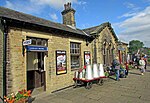Haworth, Cross Roads and Stanbury
Former civil parishes in West YorkshireGeography of the City of BradfordUse British English from November 2018West Yorkshire geography stubs

Haworth, Cross Roads and Stanbury is a former civil parish that covered the far western hinterland of the City of Bradford in West Yorkshire, England. According to the 2001 census the parish had a population of 6,566, increasing to 6,994 at the 2011 Census. As its name suggests, it covered Haworth, Cross Roads and Stanbury, with a large moorland area to the west of Stanbury. In total, the civil parish covered 1,737 hectares (4,290 acres). The parish was formed on 1 April 1999. On 1 April 2023 the parish was abolished and split to form "Cross Roads" and "Haworth and Stanbury".
Excerpt from the Wikipedia article Haworth, Cross Roads and Stanbury (License: CC BY-SA 3.0, Authors, Images).Haworth, Cross Roads and Stanbury
Prince Street, Bradford Haworth and Stanbury
Geographical coordinates (GPS) Address Nearby Places Show on map
Geographical coordinates (GPS)
| Latitude | Longitude |
|---|---|
| N 53.832 ° | E -1.945 ° |
Address
Prince Street
Prince Street
BD22 8LT Bradford, Haworth and Stanbury
England, United Kingdom
Open on Google Maps











